RECOMMENDED
A pair of powerhouse performances would make Actors Co-op’s revival of William Gibson’s Tony-winning The Miracle Worker must-see theater if only attention been paid to sightlines, or had the Co-op staged it at the David Schall Theatre next door.
Note: See update at end of review.
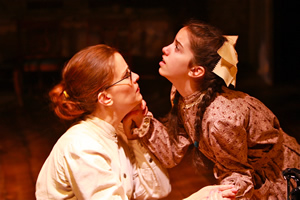 Tara Battani is phenomenal as Annie Sullivan, and matched every step of the way by the gifted Danielle Soibelman as Helen Keller, a pair of roles that won Anne Bancroft and Patty Duke matching Oscars when Goldman’s play was filmed by Arthur Penn three years after opening on Broadway.
Tara Battani is phenomenal as Annie Sullivan, and matched every step of the way by the gifted Danielle Soibelman as Helen Keller, a pair of roles that won Anne Bancroft and Patty Duke matching Oscars when Goldman’s play was filmed by Arthur Penn three years after opening on Broadway.
A half century later, The Miracle Worker remains playwriting at its emotion-packed, crowd-pleasing best. By investing real people and real events with a combination of heart, humor, and suspense, Gibson’s bio-drama tells a story that every parent and child, or teacher and student, can identify with.
The facts can be found in any history book.
Born a fully normal child, Helen Keller contracted a brief but acute illness at the age of nineteen months which left the toddler deaf and blind and her loving parents unable to deal with their wild animal of a child. Captain Arthur and his younger second wife Kate had reached the point where an institution for the mentally defective seemed their only choice when, in a last-ditch effort to keep Helen by their sides, these two desperate parents hired a 20-year-old named Annie Sullivan to attempt the seemingly impossible. It wasn’t that the Kellers expected Sullivan to work miracles, nor did Annie, a recent graduate of a school for the blind. On the other hand, having herself lost her sight as a child and undergone nine operations to restore it, it took someone like Annie to empathize with her pupil and to see hope where Helen’s parents could see almost none.
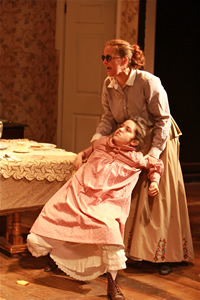 A knock-down, drag-out nine-minute fight sequence during which Annie Sullivan attempts to teach Helen to eat with a fork rather than with her hands stands out as one of the most compelling in Broadway history, and would be one of the most memorable in Actors Co-op’s twenty-one seasons … if you could see it all. Unfortunately, insufficiently raked seating prevents many audience members from seeing over the heads of those in front of them, a problem exacerbated by a front row of seats right at stage level that block views of just about anything below actors’ waists. Since much of this justly famed sequence (and a number of others as well) have Helen and/or Annie grappling or otherwise interacting at floor level, only constant head craning makes any kind of view possible.
A knock-down, drag-out nine-minute fight sequence during which Annie Sullivan attempts to teach Helen to eat with a fork rather than with her hands stands out as one of the most compelling in Broadway history, and would be one of the most memorable in Actors Co-op’s twenty-one seasons … if you could see it all. Unfortunately, insufficiently raked seating prevents many audience members from seeing over the heads of those in front of them, a problem exacerbated by a front row of seats right at stage level that block views of just about anything below actors’ waists. Since much of this justly famed sequence (and a number of others as well) have Helen and/or Annie grappling or otherwise interacting at floor level, only constant head craning makes any kind of view possible.
A far better choice would have been the neighboring Schall Theatre. Yes, the larger Schall’s proscenium stage would have meant sacrificing a certain intimacy. Still, unobstructed sightlines, greater room for Annie and Helen’s fight, and the need for less moving around of furniture and props would have made for a more completely satisfying production.
Fortunately, with Co-op treasure Battani and young theater vet Soibelman giving career-defining performances, even a less than optimal staging makes for exciting theater under Thom Babbes’ otherwise excellent direction.
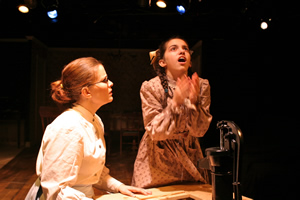 A two-time Scenie winner for night-and-day different performances in Days Of Wine And Roses and The Traveling Lady, the always marvelous Battani invests Annie with spunk, determination, good humor, and heart, convincing us that while scarcely out of her teens, Sullivan was well up to the task of not only teaching this most unique of pupils but also of standing up to Helen’s authoritarian father and her loving but overly indulgent mother. Battani has been wonderful before, but never more so than in this performance eminently deserving of award consideration.
A two-time Scenie winner for night-and-day different performances in Days Of Wine And Roses and The Traveling Lady, the always marvelous Battani invests Annie with spunk, determination, good humor, and heart, convincing us that while scarcely out of her teens, Sullivan was well up to the task of not only teaching this most unique of pupils but also of standing up to Helen’s authoritarian father and her loving but overly indulgent mother. Battani has been wonderful before, but never more so than in this performance eminently deserving of award consideration.
Opposite Battani, musical theater star par excellence Soibelman proves that even without singing a note in her powerhouse voice (or speaking more than a single word, for that matter), she is one superb dramatic actress. Grasping for whatever is within reach, whether to guide herself around the family home, or out of hunger or simply childish selfishness, Soibleman is a wonder, and if you want proof of just how thoroughly she has convinced you that she is this deaf, blind “problem child” with an intelligence just begging to be set free, wait till you see her bright-eyed smile at curtain calls. The intelligence was real, the deafness and blindness brilliant illusion.
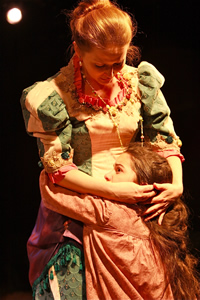 A third actress shines brightly at the Co-op, and that is Catherine Gray in the role of Kate Keller, Helen’s young mother and Captain Keller’s second wife, driven to the point of near despair yet still clinging to hope. For The Miracle Worker to work, we must believe that Helen needs her mother’s love as much as she needs Annie’s teaching, something that Gray convinces us of, and then some.
A third actress shines brightly at the Co-op, and that is Catherine Gray in the role of Kate Keller, Helen’s young mother and Captain Keller’s second wife, driven to the point of near despair yet still clinging to hope. For The Miracle Worker to work, we must believe that Helen needs her mother’s love as much as she needs Annie’s teaching, something that Gray convinces us of, and then some.
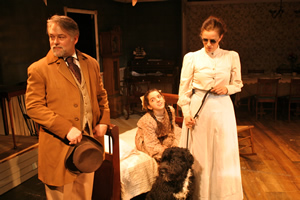 Bruce Ladd does his accustomed fine work as the well-meaning but often ineffectual Captain Keller, whose attempts at wearing the pants in his family often fall flat when up against the juggernaut that is Annie Sullivan.
Bruce Ladd does his accustomed fine work as the well-meaning but often ineffectual Captain Keller, whose attempts at wearing the pants in his family often fall flat when up against the juggernaut that is Annie Sullivan.
As James Keller, handsome young Tony Christopher is another cast standout, making the Captain’s son by his first wife far more than just a peevish, ineffectual thorn in his father’s side, but someone deserving of both love and respect.
Chinyere Nwodim is terrific as African-American servant Viney, there to observe and tsk-tsk the Keller family foibles, with Phil Crowley and Joanne Atkinson providing topnotch support, the former as both infant Helen’s doctor and Annie’s counselor at the Perkins Institution for the Blind, the latter as the Captain’s sister Aunt Ev.
Brothers Jakobe and Jayce Dempsey double as servant boy Percy, and if an announcement was made or posted as to which one went on winningly last night, I missed it. Kassandra Carrington is a petite charmer as Martha, while Kara Bigham, Alex Gabriel, Ariana Gabriel, and Mackenzie Konjoyan are adorable and convincing as the blind children whom Annie must leave behind when she heads off to teach Helen. Finally, Tate Downing is heartbreakingly real as Jimmie, the young brother whose brief life and tragic death haunts Annie Sullivan.
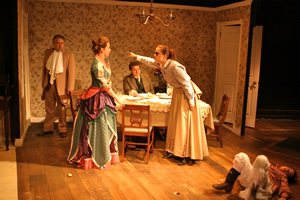 Scenic designer Mark Svastics is mostly successful at squeezing The Miracle Worker’s many locales onto the tiny Crossley Theatre stage, superimposing the Keller’s garden house onto the main stage area with the aid of lighting designer Bill E. Kickbush, doing highly effective work throughout. Still, there are times when it’s not clear whether we are indoors or out, or which door leads to which space. Shon LeBlanc’s late-1880s costumes have just the right period feel, with special snaps for Kate’s elegant corseted finery. Kudos go too to properties designers Nicholas Aracini and Micah Embry for their many contributions to a prop-heavy show. Cooper Babbes’s original music sets just the right dramatic mood. Best of all is Fritz Davis and James Arnold Taylor’s multi-layered sound design, one which allows us to hear a horse-drawn carriage approaching, or a rooster cock-a-doodle-dooing in the distance, or (working with lighting designer Kickbush) giving Annie’s dream flashbacks to Jimmie a nightmarishly surreal quality. Jeff Charlton, Sheryl Bernstein, and James Arnold Taylor deserve snaps, too, for creating the prerecorded voices inside Annie’s head.
Scenic designer Mark Svastics is mostly successful at squeezing The Miracle Worker’s many locales onto the tiny Crossley Theatre stage, superimposing the Keller’s garden house onto the main stage area with the aid of lighting designer Bill E. Kickbush, doing highly effective work throughout. Still, there are times when it’s not clear whether we are indoors or out, or which door leads to which space. Shon LeBlanc’s late-1880s costumes have just the right period feel, with special snaps for Kate’s elegant corseted finery. Kudos go too to properties designers Nicholas Aracini and Micah Embry for their many contributions to a prop-heavy show. Cooper Babbes’s original music sets just the right dramatic mood. Best of all is Fritz Davis and James Arnold Taylor’s multi-layered sound design, one which allows us to hear a horse-drawn carriage approaching, or a rooster cock-a-doodle-dooing in the distance, or (working with lighting designer Kickbush) giving Annie’s dream flashbacks to Jimmie a nightmarishly surreal quality. Jeff Charlton, Sheryl Bernstein, and James Arnold Taylor deserve snaps, too, for creating the prerecorded voices inside Annie’s head.
Lindsay Capacio is stage manager and Katy Davis assistant stage manager. The Miracle Worker is produced by Seleh Victor.
Battani, Soibelman, and the rest of The Miracle Worker cast and creative team deserve a stage-and-seating set-up worthy of their talents. With so much going for it, it’s a shame that poor sightlines prove such a detriment to an audience’s unadulterated involvement in what otherwise would be a nigh-on perfect production of a true American theater classic.
Update: Actors Co-op has informed me that the front row of house-right seats referred to in this review has been removed, and that blocking has been revised to insure that the story that is told is being seen.
Actors Co-op, 1760 N. Gower St., Hollywood.
www.actorsco-op.org
–Steven Stanley
April 20, 2013
Photos: Lindsay Schnebly


 Since 2007, Steven Stanley's StageSceneLA.com has spotlighted the best in Southern California theater via reviews, interviews, and its annual StageSceneLA Scenies.
Since 2007, Steven Stanley's StageSceneLA.com has spotlighted the best in Southern California theater via reviews, interviews, and its annual StageSceneLA Scenies.







 COPYRIGHT 2024 STEVEN STANLEY :: DESIGN BY
COPYRIGHT 2024 STEVEN STANLEY :: DESIGN BY